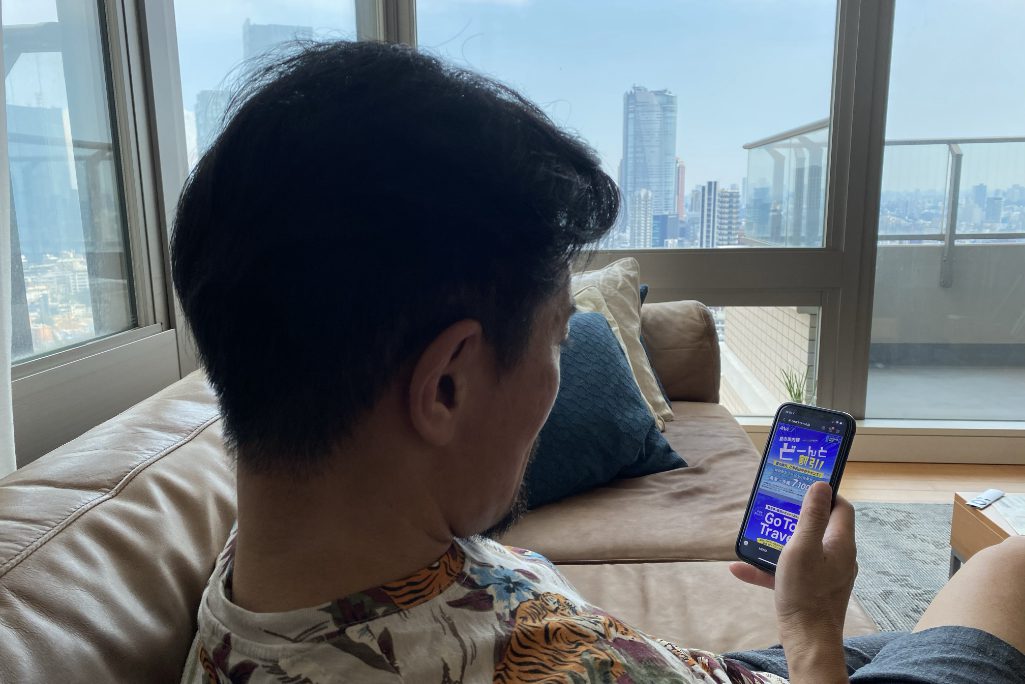Skift Take
Take a look at how Japan's most popular messaging app has approached travel marketing during the pandemic. It's a glance at how superapps might define the future of travel in Asia.
Japan is trying to boost domestic tourism without spreading the pandemic by targeting travel discounts for residents in specific areas. But many online marketing tools struggle to be that precise with geographic targeting.
Enter, the country’s most popular messaging app, Line, which knows where its users live and can target users with relevant travel ads accordingly.
Line’s geo-targeting is one of a few examples of how Japan has approached the challenge of bolstering its domestic tourism during a pandemic in ways that are subtly different from how brands in Europe and North America have addressed the same problem.
The jury is still out on whether the messaging app’s sub-brand, Line Travel jp, has adapted as well as it could to the crisis. But its distinctive approach may help shake the settled assumptions of executives elsewhere about how online travel has to work.
The messaging app’s merger with Yahoo Japan is slated to close sometime after October, creating a company with combined revenue of $11 billion per year. Line is headquartered in South Korea but is Japan’s most popular messaging app.
Geo-Targeting Travel Ads
Line’s core service is instant messaging, like WhatsApp. Line’s travel brand offers price-comparison search, similar to metasearch brands like Kayak, Skyscanner, Trivago, and HomeToGo. But Line approaches messaging and metasearch differently than other companies. The interaction between the parent company and the travel brand has enabled some creativity during the pandemic.
Join Us For Our Skift Global Forum Online Conference September 21-23
Japan has run the world’s most assertive push to revive domestic tourism with its “Go To” travel campaign. The government has subsidized vouchers with discounts for up to half-off for domestic tourism.
Yet hotels and destinations wish to target their marketing to residents in particular areas while excluding those in other areas, such as Tokyo, where the pandemic has been flaring.
The need for targeted marketing has highlighted one of Line’s strengths. Users of Line’s messaging app stay logged in with identifiable information, enabling Line to target relevant notifications. Users of the app can follow Line’s travel brand as “friends” of the brand. So far 22.1 million have done so, opting into notifications.
Line’s travel brand can send a notification with a particular tourism promotion only to residents of specific areas. It recently sent out a notification only to residents of the Gifu Prefecture, a mountainous area in the center of the country’s main island, with about 2 million residents. The brand alerted the users to travel discounts only available to residents.
Line can segment users in other ways, such as only targeting notifications at users who are of a younger age group considered more likely to travel during a pandemic.
To be sure, other digital brands in the world, such as Airbnb’s HotelTonight, have long offered geo-targeted ads based on where they guess a user is. Yet Line takes advantage of information its users have told it to build detailed, accurate views of customers. That knowledge helps ensure that it only sends users promotions that qualify for the government’s travel subsidy program or meet a supplier’s own restrictions. The notification normally directs people to book via the reseller or supplier itself, such as Expedia.
Line’s travel brand plans to use its intel that a user has an upcoming trip to up-sell other items relevant at the destination, such as restaurant reservations or local tours and activities.
Ad Auction Flexibility
Line Travel Jp hasn’t created “instant” or “direct” booking interfaces where users stay to complete a booking within its own site or app.
“But our systems track bookings and keep records of transactions matching with Line IDs,” Kei Shibata, co-founder and CEO of Line Travel Jp. “We know a user booked a hotel through, say, Booking.com for a specific destination at a specific price.”
Many other metasearch companies lack access to that booking data.
That booking data matters. Line lets travel companies bid for ad placements in its metasearch by using the cost-per-acquisition (CPA) model — sometimes called a commission model. Being able to track if a booking is completed is critical to making the cost-per-acquisition model work.
Other metasearch brands typically invite companies to bid on ad placements using a cost-per-click (CPC) model. Advertisers pay when a customer “clicks through” to their site or app whether or not the customer actually books.
But suppliers, such as hoteliers, often prefer the CPA, or commission, model during this time of low revenue because the marketing expenditures result in actual transactions.
“CPA is our main model, while we also sell our push messaging slots for a fixed fee as a pure advertising model,” Shibata said. “We offer the CPC model primarily introduced for local travel agencies to sell tour packages.”
“Large brands like ANA, JAL, and Hilton also prefer the fixed-fee model, or pure advertisement model, for branding purposes since they’re shifting their brand marketing budgets from mass media such as TV to major digital media such as Line or Yahoo! Japan,” Shibata said.
Line isn’t alone. Google began offering to small hotel companies in April pay-per-stay and pay-per booking commission models for its Google Hotel Ads product. It had previously limited the commission-based models to big brands under limited circumstances.
Travel Loyalty Twist
Bookings done via the cost-per-acquisition model bring data that can feed into its loyalty program.
People who book trips through Line Travel Jp can earn Line loyalty points, as Skift reported in October 2019 when the feature rolled out. Right now, users can redeem these points for a cash-equivalent that they can tap to buy everyday items at convenience stores and elsewhere via Line Pay, Line’s payment service. Some travel companies, such as Trip.com, now accept Line Pay for buying travel.
Loyalty programs sway Japanese consumers in their shopping decisions. The Ponta network lets people earn points for bookings made via travel agencies Jalan, H.I.S., and Japan Airlines with an assortment of other non-travel merchants, such as Kentucky Fried Chicken. Tpoints is another loyalty point consortium started by retailer Tsutaya has Airbnb and Yahoo Japan as members.
Hiring Travel Influencers
Most metasearch brands attract users who have already decided to travel. They struggle with the “inspiration” part of online booking.

Bamboo in Arashiyama, the Arashi Mountain Forest Source: JNTO
This content attracts users via Google and Yahoo search and social media into LINE Travel Jp’s browser-based interface that sits outside the messaging app. The content also appears on the messaging app as well as Line News channel, a feed of news sourced from various content providers.
“We’re preparing to collaborate with destinations to send these influencers to create virtual tours,” Shibata said. “We’ll distribute those virtual tours via Line messages.”
For more context, see our recent articles on the future of travel influencers and press trips.
Before the pandemic, about 70 percent of Line Travel Jp’s bookings were for domestic travel. Domestic takes nearly all the share today. For more insight on Japanese tourism today, read Skift’s story on how the tourism groundwork laid by Japan for the Tokyo 2020 Olympic Game is still likely to bear fruit.
Uncertain Future
The fate of Line’s Japanese travel business depends heavily on how well the parent company’s merger with Yahoo Japan works out.
The merger could potentially thrust Line and Yahoo Japan ahead of domestic rival Rakuten among mobile users in southeast Asia, Line said. The merger will juice traffic to Line’s travel business in Japan, which drew 17 million monthly users in August 2019 — twice as many as Booking.com and Expedia received, according to SimilarWeb. The new combined traffic could overtake Tripadvisor’s.
Or at least that’s the hope.
The merger’s goal is to create a superapp like WeChat and Grab, where users can send messages, make payments, browse news, book travel and open the guest door at hotels and rentals, and shop all in one app.
“The future of travel distribution in Asia is superapps,” Shibata said.
For context, see Skift’s Deep Dive “Google Maps Is Ready to Transform the World of Superapps.”
Register Now For Skift Global Forum, Happening Online September 21-23
The Daily Newsletter
Our daily coverage of the global travel industry. Written by editors and analysts from across Skift’s brands.
Have a confidential tip for Skift? Get in touch
Tags: asia, japan, messaging, metasearch, superapps
Photo credit: A user in Tokyo looks at information about the country's domestic tourism campaign via the LineTravel.jp superapp. Line Travel Japan is helping the country try to boost tourism without spreading the pandemic by targeting discounts to residents of specific areas. LineTravel.jp
